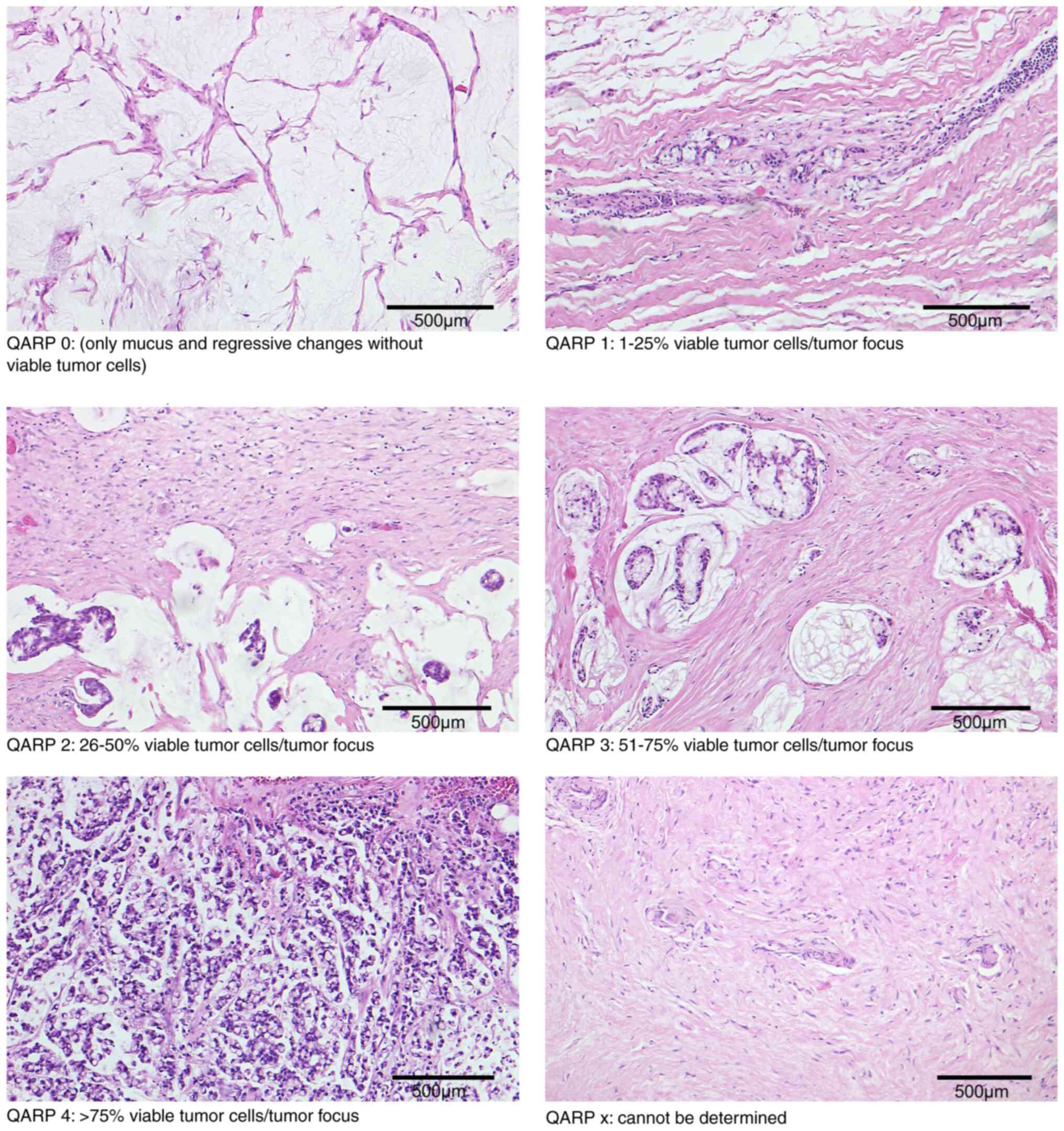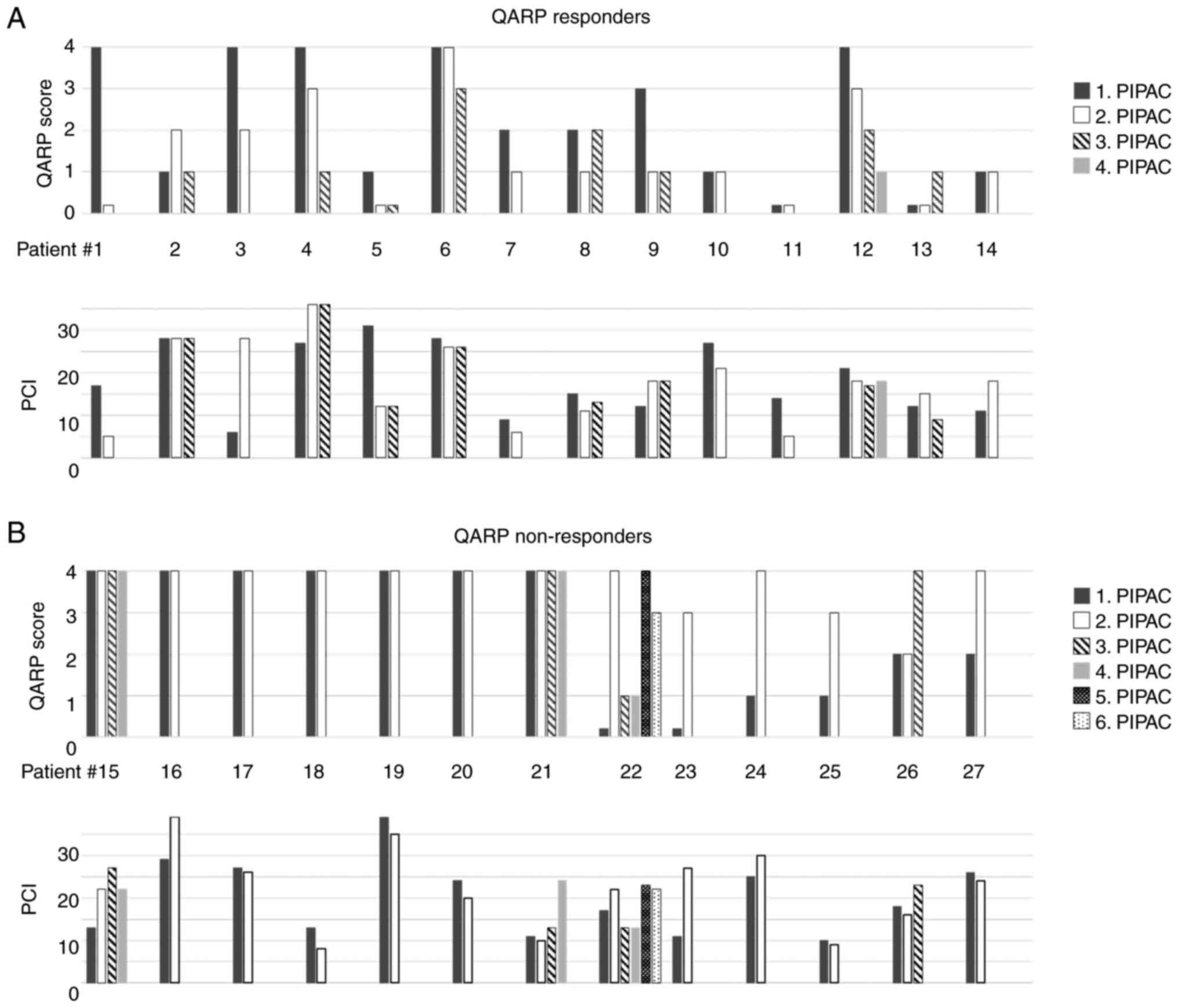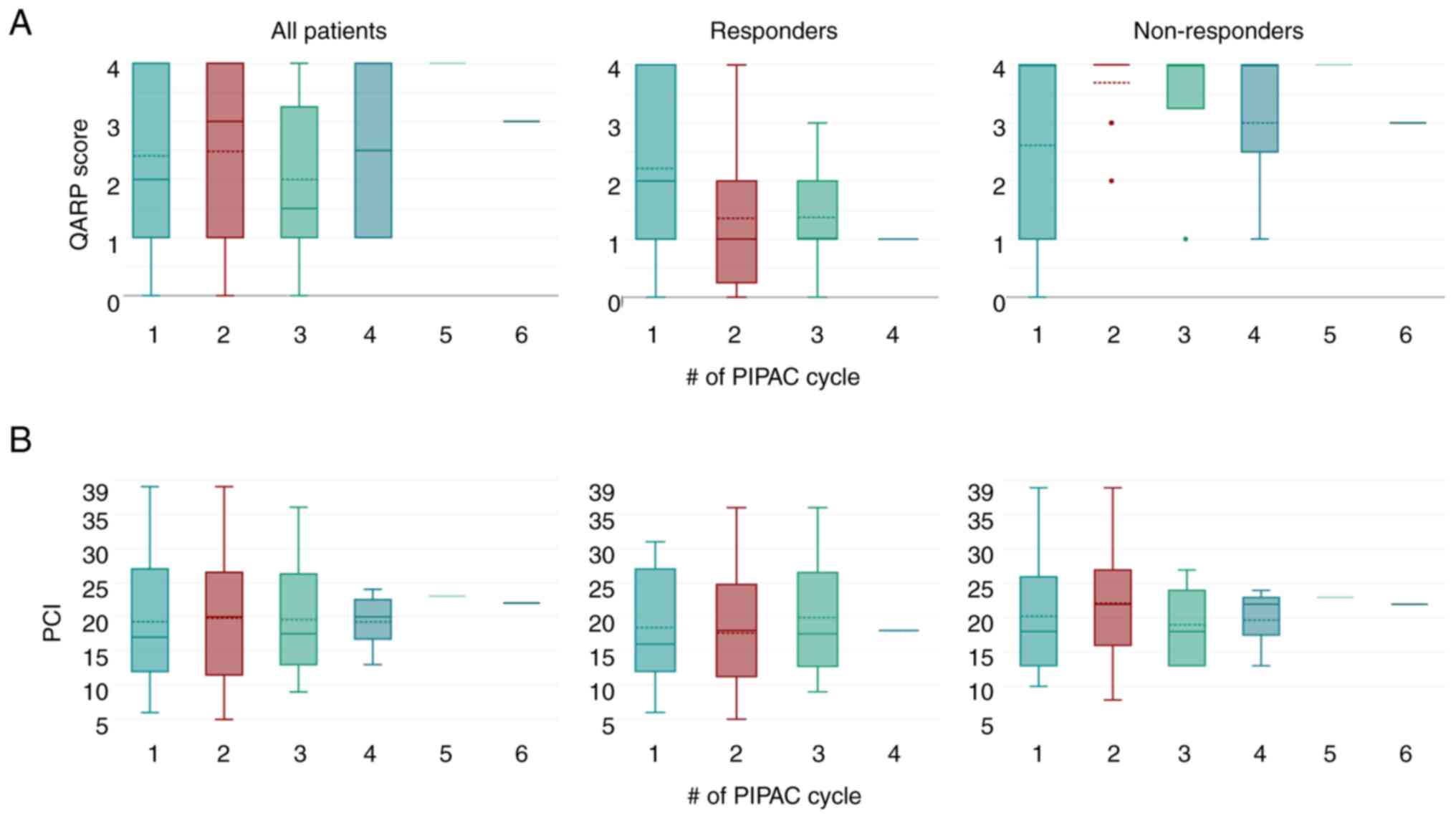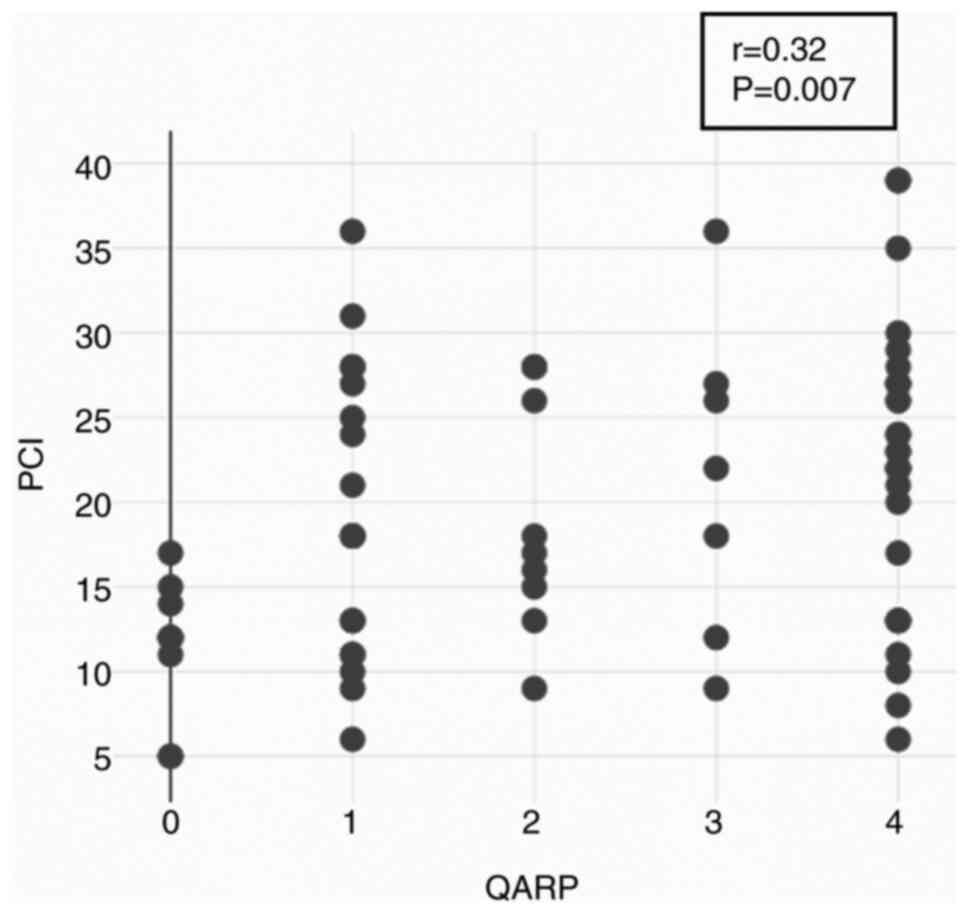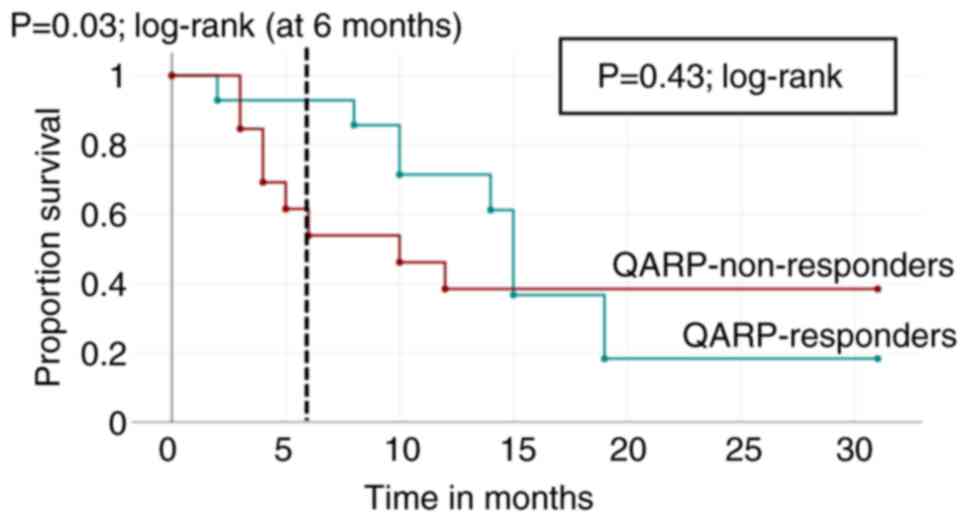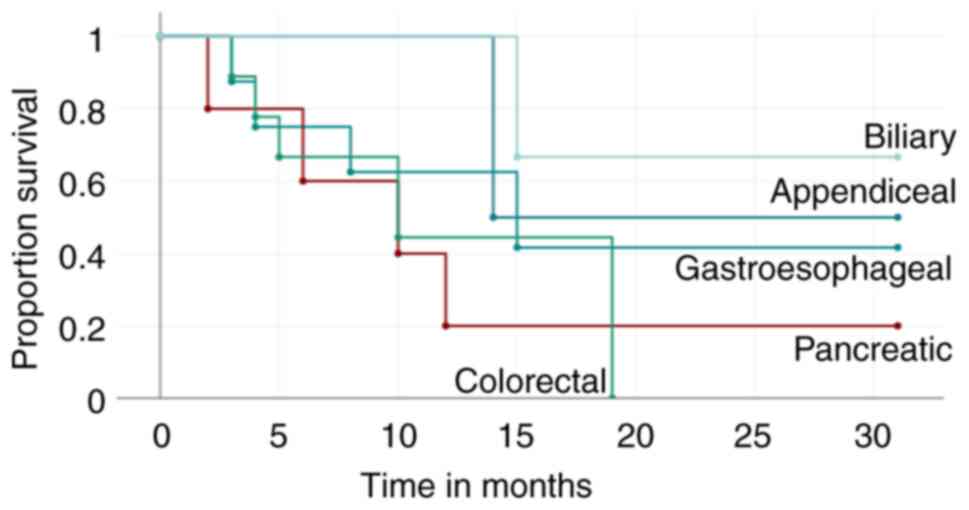Modified scoring system for the quantitative assessment of histological regression in peritoneal carcinomatosis after pressurized intraperitoneal aerosol chemotherapy: A pilot study
- Authors:
- Published online on: May 9, 2024 https://doi.org/10.3892/ol.2024.14441
- Article Number: 308
-
Copyright: © Abbas et al. This is an open access article distributed under the terms of Creative Commons Attribution License.
Abstract
Introduction
Gastrointestinal cancers account for 26% of the global cancer burden and 35% of all cancer-related deaths. In 2018, there were an estimated 4.8 million new cases and 3.4 million deaths related to gastric cancer worldwide (1). Peritoneal carcinomatosis is one of the leading causes of death in patients with gastrointestinal cancers. For example, up to 30% of colorectal cancer patients will develop peritoneal metastases in the course of their disease (2). Therapeutic options include cytoreductive surgery of all peritoneal disease combined with or without hyperthermic intraperitoneal chemotherapy (HIPEC) (3). While cytoreductive surgery is a potentially curative option, only about a fraction of patients qualifies for resection due to extensive peritoneal disease and/or synchronous metastases at additional sites which cannot be completely resected. Pressurized intraperitoneal aerosol chemotherapy (PIPAC) is another recent therapy proposed for patients with peritoneal carcinomatosis (4–10). During the PIPAC procedure, laparoscopy is performed, biopsies are taken, and chemotherapeutic drugs are delivered into the abdominal cavity as an aerosol under pressure (11,12). The PIPAC procedure is usually repeated every four to eight weeks. It is a minimally invasive procedure which can usually be performed via two small incisions, so recovery time and hospital stay are short and patients can often continue with their next chemotherapy cycle without any delay caused by the operation. As long as a minimally invasive approach is feasible and the patient can undergo anesthesia safely, PIPAC can be performed. Initially, PIPAC was introduced for very advanced peritoneal carcinomatosis (13–16) and was recently proposed for the use in a neoadjuvant and adjuvant setting (17,18) to allow for the regional treatment of the peritoneal surfaces. Studies have shown that PIPAC is safe, well tolerated, and can improve the quality of life in patients with peritoneal carcinomatosis (19–25). Two methods can be employed to assess treatment response in patients. The Peritoneal Cancer Index (PCI) according to Sugarbaker (26) is determined during laparoscopy to quantify the extent of the disease macroscopically. The presence and size of peritoneal cancer nodules in 13 defined abdominal regions is assessed and a score is assigned (27,28). PCI ranges from 0 (indicating no visible peritoneal implants) to 39 (peritoneal cancer everywhere) and a change over time is associated with treatment response (28). Another classification method is the histological assessment of peritoneal biopsies taken during laparoscopy. In 2016, Solass et al (29) introduced the four-tiered peritoneal regression grading score (PRGS) to assess the response to chemotherapy in peritoneal metastasis by histology (30). The PRGS is based on the presence of residual tumor cells and/or the extent of regressive features such as fibrosis, accumulation of macrophages, necrosis, or presence of mucin with or without tumor cells. To determine the score, the proportion between both is assessed (31). PRGS distinguishes between four scenarios: complete response (absence of tumor cells), major response (predominant regressive changes), minor response (mainly viable tumor cells) and no response (no regressive changes) (29). Here, we present a new variation of the PRGS scoring system based on quantitative assessment of histological regression in peritoneal carcinomatosis (QARP) after PIPAC treatment. QARP combines elements of the PRGS with a semiquantitative assessment of tumor cells versus regressive changes. A semiquantitative scoring system is in line with the standard practice at our institute for the assessment of cancer specimens and is being used in established regression scores for various cancer types.
Materials and methods
Peritoneal biopsies
Following approval by Institutional Ethics Committee of Ärztekammer Westfalen-Lippe (2022-850-f-S), we examined samples from 27 patients with gastrointestinal cancers and peritoneal metastasis of various origins including esophageal, gastric, pancreatic, biliary, appendiceal, and colorectal who had undergone two to six PIPAC procedures (a total of 72 PIPACs) at the University Hospital Muenster Department of Surgery between May 2020 and August 2022. Median age was 62 years ranging from 41 to 82. Patients with colorectal primaries received PIPAC with oxaliplatin 120 mg/m2 BSA (body surface area), patients with all other primary cancers received PIPAC with doxorubicin 2.1 mg/m2 BSA and cisplatin 10.5 mg/m2 BSA. During the laparoscopic procedure, PCI was determined according to the Sugarbaker classification (26) and peritoneal biopsies were taken from cancerous lesions in different abdominal quadrants, embedded in formalin, and processed in standardized fashion by the Gerhard-Domagk Institute of Pathology at the University Hospital Muenster. Briefly, fresh biopsies were fixated in 10% buffered formalin for 24 to 48 h, embedded in paraffin, under controlled temperature, cut in 3 to 5 µm sections and stained with hematoxylin and eosin (H&E) and Periodic Acid-Schiff (PAS) according to standardized protocols.
Peritoneal cancer regression score
Histological assessment of the peritoneal biopsies was performed by two board certified pathologists (MA, EW). Microscopic features of regression, previously published by Solass et al, included mucin without cells, fibrosis, infarct-like-necrosis, inflammatory changes with giant cells, and lipid-laden foamy macrophages (Fig. S1) (29). The samples were scored according to our grading system by quantitative assessment of viable tumor cells in relation to the tumor focus (Table I). The five-tiered system was graded as follows: Grade 0-no residual tumor cells with regressive changes present; grade 1–1 to 25% viable tumor cells per tumor focus with regressive changes present; grade 2–26 to 50% viable tumor cells per tumor focus with regressive changes present, grade 3–51 to 75% viable tumor cells per tumor focus with few regressive changes; grade 4-more than 75% viable tumor cells per tumor focus with minimal or no regressive changes (Fig. 1). If there was no clear evidence for regressive changes in the absence of tumor cells, QARP was graded as ‘x’-cannot be determined. The histopathological features of viable tumor cells were characterized by hyperchromatic nuclei, eosinophilic cytoplasm, mitotic figures, and/or apoptosis. As mentioned above, regressive changes were associated with fibrosis, mucin without cells, necrosis, and inflammatory changes with giant cells. Surrounding tissue without any sign of previously present tumor cells was excluded from the quantitative assessment. Patient data was extracted by chart review of the electronical medical record. The median follow-up time was 10.2 months.
Statistical analysis
Data was analyzed using Datatab Online Statistics Calculator (https://datatab.net/statistics-calculator/descriptive-statistics). Spearman's rank correlation coefficient was calculated to examine the relationship between QARP and PCI. Survival data was plotted on Kaplan Meier curves and compared using log-rank test. P<0.05 was considered to indicate a statistically significant difference.
Results
Patient characteristics
The median age of patients included in this study was 62 years at the time of the first PIPAC. There were 13 male (48.1%) and 14 female (51.9%) patients. The primary cancer origins were as follows, esophagogastric in 8 patients (29.6%), colorectal in 10 patients (37.0%), pancreatic in five patients (18.5%), biliary in three patients (11.1%) and appendiceal in two patients (7.4%) (Table II). Patients with colorectal primaries received PIPAC with oxaliplatin 120 mg/m2 BSA, patients with all other primary cancers received PIPAC with doxorubicin 2.1 mg/m2 BSA and cisplatin 10.5 mg/m2 BSA. The one patient with two primaries (pancreatic and colorectal) was treated with doxorubicin/cisplatin. PIPAC procedure was performed according to a standardized protocol.
Regressive changes of peritoneal carcinomatosis determined by QARP
Regressive changes within the peritoneal biopsies were determined by QARP for each PIPAC cycle. QARP scores for each patient and procedure were plotted on a graph depicting the development over time (Fig. 2). If biopsies from the same procedure revealed different QARP scores, the highest score was plotted. Nine patients showed improvement in QARP scores over time and 5 patients had stable low QARP scores (QARP 0 or 1) in every procedure. These patients were labelled as ‘QARP responders’ (Fig. 2A). For comparison, matching PCI values were plotted below the QARP scores (Fig. 2A). Thirteen patients had either stable high QARP scores (QARP 4) or worsening scores over time. These patients were labelled as ‘QARP non-responders’ (Fig. 2B). Once more, for comparison, matching PCI values were plotted below the QARP scores (Fig. 2B). Looking at the group of responders to treatment (n=14), an improvement in QARP score was noted from a median of QARP 2 at the first PIPAC procedure to median QARP of 1 at the second and subsequent PIPAC procedures (Fig. 3A, middle panel). ‘QARP non-responders’ already started with a median QARP score of 4 at the first PIPAC procedure and remained at that level during the following PIPAC procedures (Fig. 3A, right panel). For comparison, matching PCI values were plotted below the QARP scores (Fig. 3B).
Correlation of QARP and PCI
PCI scores for each patient and procedure were compared with QARP scores for each patient and procedure, and the Spearman correlation was calculated. QARP and PCI showed a weak, but significant, positive correlation (r=0.32; P=0.007), i.e., higher QARP scores correlated with higher PCI scores (Fig. 4).
Survival curves
Survival times for QARP responders and QARP non-responders, as defined above, were plotted on a Kaplan-Meier graph. The survival curves diverge in the first months, with a significant survival advantage for QARP responders at 6 months (P=0.03; log-rank), but eventually intersect at 15 months (Fig. 5). There is no significant difference in long-term overall survival between QARP responders and non-responders in our cohort at the end of the observation period (P=0.43; log-rank) (Fig. 5). For comparison, survival curves grouped by primary cancer type were calculated (Fig. 6).
Discussion
Tumor regression scores following chemotherapy and/or radiotherapy find applications across various primary and metastatic cancers in assessing treatment efficacy. Notably, the Mandard system introduced in 1994 delineates five tumor regression grades (TRG) for esophageal carcinoma treated with preoperative chemoradiation (32). TRG 1 signifies complete regression with no residual cancer cells alongside fibrosis of the esophageal wall, TRG 2 indicates fibrosis with scattered tumor cells, TRG 3 is defined as predominant fibrosis with an increased number of residual cancer cells, TRG 4 shows a relative abundance of cancer compared to fibrosis of the esophageal wall, and TRG 5 signifies no regressive changes (32). In 2003, Becker et al defined a regression score for adenocarcinoma of the esophagogastric junction (33) distinguishing grades as follows: grade 1a (complete tumor regression), grade 1b (<10% of vital tumor tissue), grade 2 (10 to 50% residual tumor per tumor bed), and grade 3 (>50% of viable tumor remaining). In 2004, Baldus et al introduced a semiquantitative system to evaluate regressive changes after neoadjuvant treatment of locally advanced esophageal cancers demonstrating a favorable prognosis for patients with greater than 90% regression (34). Dworak et al proposed a system assessing the regression of primary rectal cancer following chemoradiation (35), while Rubbia-Brandt et al and Blazer et al presented systems for evaluating response in liver metastases of colorectal origin using semiquantitative methods (36,37). In the context of assessing peritoneal metastases from gastrointestinal carcinomas after PIPAC therapy, Solass et al established the peritoneal regression grading system (PRGS), confirming its reproducibility and low interobserver variability (29,38). The PRGS hinges on the presence of residual tumor cells and the extent of histological regressive features, paralleling the basis of the QARP score. Viable tumor cells are characterized by hyperchromatic nuclei, eosinophilic cytoplasm, mitotic figures, and/or apoptosis. Conversely, regressive changes involve fibrosis, mucin devoid of cells, necrosis, and inflammatory changes with giant cells. The PRGS distinguishes complete response (absence of tumor cells), major response (predominant regressive changes), minor response (mainly viable tumor cells) and no response (no regressive changes) (29).
Our new scoring system combines elements of the PRGS with a semiquantitative assessment of tumor cells versus regressive changes. It calculates the percentage of tumor cells and regressive changes in each tumor focus, assigning scores based on the proportion of viable tumor cells per focus paralleling established cancer regression scores, such as the regression scores according to Becker et al (33) and Baldus et al (34). Tissue surrounding a focus with no signs of regression pointing toward previous tumor cells is excluded from quantitative assessment. Biopsies showing neither tumor cells nor clear regressive features denoting a treatment response of previous tumor cells are graded as ‘x’ (indeterminable), avoiding overestimation of treatment response. Fortunately, such instances were rare. Given multiple biopsies were taken during each PIPAC procedure, there was sufficient material to assign at least one QARP score to each patient and procedure. As biopsies were routinely taken from different abdominal quadrants, we sometimes found-in the same patient-biopsies with regressive features without tumor cells, while others had nearly completely viable tumor cells. This raised the question of differing treatment responses or whether areas without tumor cells and only regressive changes were initially not involved by peritoneal cancer, but simply reflected the response of ‘normal’ non-diseased peritoneum to prior treatment. The PIPAC procedure itself can result in chemical peritonitis and subsequent histological changes of the non-diseased peritoneum, which can be difficult to distinguish from complete regression. To prevent overestimation of treatment response, we routinely selected the highest score as a reference score when comparing scores over time. Thus, a potential misinterpretation of reactive change in non-diseased peritoneum as complete regression was avoided. When using PRGS in the past, we frequently found ourselves struggling with the assignment of the highest score, PRGS 4, indicating ‘no response’, as fibrous tissue can be part of the ‘normal’ stroma of a viable tumor or sign of fibrotic regressive changes. Therefore, biopsies with a small amount of connective tissue within the tumor focus could be interpreted as PRGS 4 assuming it was normal tumor stroma, or interpreted as PRGS 3, assuming we were looking at fibrosis suggesting a minimal regressive response. As differentiating between these two can be challenging, we were risking erroneous lower scores by categorizing biopsies as ‘partial response’ rather than ‘no response’. In addition, we were wondering if it was actually clinically relevant to discriminate between ‘no response’ and a minimal response which would be displayed as two different scores, namely PRGS 4 and PRGS 3. To overcome this limitation, we decided to create a five-tiered system, with the highest QARP score, grade 4, translating to over 75% of viable tumor cells per focus, thus grouping patients with a minimal and no response together. As semiquantitative scores are routinely used at our institute, introduction of the QARP score was seamless and it was adopted readily by our pathologists.
A limitation of our study is the rather small and mixed patient cohort. This is not surprising, as patients with peritoneal carcinomatosis form a heterogenous group due to the different tumor origins. In addition, PIPAC is far from being the standard of care for patients with peritoneal metastases despite its growing acceptance and evidence for its usefulness. PIPAC is only performed at specialized centers and, as a result, only a fraction of patients who would be candidate for it, are actually offered PIPAC treatment. We cannot show a significant difference in survival between what we defined as QARP responders and non-responders which might be due to the small number of patients in our study. Interestingly, the survival curves diverge in the first months and at 6 months, from the time of the first PIPAC, there is still a significant difference in survival suggesting that there might be a survival advantage early after initiation of PIPAC treatment when comparing QARP responders and non-responders. Given our small cohort, we did not stratify our patients further according to the primary tumor origin which will be the goal of a future study. However, even in our small cohort, we find a significant correlation between QARP and PCI, a well-established score that has been used for decades in patients with peritoneal metastases and has been shown to be of prognostic relevance by itself (28). In contrast to the PRGS, we employed a five-tiered system which can allow for enhanced subgroup differentiation, especially when analyzing larger number of patients. Future studies with larger patient cohorts will be able to further delineate the prognostic value of the QARP score and confirm its usefulness.
In conclusion, QARP, our newly developed regression score for peritoneal carcinomatosis following PIPAC, represents an advancement built upon the foundation of the established PRGS. Throughout our patient cohort, QARP proved to be a useful tool in quantifying treatment response post-PIPAC. Further studies incorporating larger patient cohorts will be able to further delineate the prognostic value of the QARP score and confirm its usefulness.
Supplementary Material
Supporting Data
Acknowledgements
Not applicable.
Funding
Funding: No funding was received.
Availability of data and materials
The data generated in the present study may be requested from the corresponding author.
Authors' contributions
MA and JCS conceptualized the study. MA and EW performed the histological analysis. MA, JPR, DECB, AP and JCS collected, analyzed and interpreted the data. MA, JPR and JCS wrote the original draft of the manuscript. DECB, AP and EW reviewed and edited the manuscript. JCS supervised the project. MA, JPR, DECB and JCS confirm the authenticity of all the raw data. All authors read and approved the final version of the manuscript.
Ethics approval and consent to participate
The study was conducted in accordance with the Declaration of Helsinki, and was approved by Institutional Ethics Committee of Ärztekammer Westfalen-Lippe (approval no. 2022-850-f-S, date of approval: October 1, 2023). Written informed consent was obtained from all participants.
Patient consent for publication
Not applicable.
Competing interests
The authors declare that they have no competing interests.
Glossary
Abbreviations
Abbreviations:
|
HIPEC |
hyperthermic intraperitoneal chemotherapy |
|
PIPAC |
pressurized intraperitoneal aerosol chemotherapy |
|
PCI |
peritoneal cancer index |
|
PRGS |
peritoneal regression grading score |
|
QARP |
quantitative assessment of histological regression in peritoneal carcinomatosis |
|
H&E |
hematoxylin and eosin |
|
PAS |
periodic acid-Schiff |
|
BSA |
body surface area |
|
TRG |
tumor regression grade |
References
|
Arnold M, Park JY, Camargo MC, Lunet N, Forman D and Soerjomataram I: Is gastric cancer becoming a rare disease? A global assessment of predicted incidence trends to 2035. Gut. 69:823–829. 2020. View Article : Google Scholar : PubMed/NCBI | |
|
Koppe MJ, Boerman OC, Oyen WJ and Bleichrodt RP: Peritoneal carcinomatosis of colorectal origin: Incidence and current treatment strategies. Ann Surg. 243:212–222. 2006. View Article : Google Scholar : PubMed/NCBI | |
|
Sugarbaker PH, Landy D and Pascal R: Intraperitoneal chemotherapy for peritoneal carcinomatosis from colonic or appendiceal cystadenocarcinoma: Rationale and results of treatment. Prog Clin Biol Res. 354B:141–170. 1990.PubMed/NCBI | |
|
Khomyakov V, Ryabov A, Ivanov A, Bolotina L, Utkina A, Volchenko N and Kaprin A: Bidirectional chemotherapy in gastric cancer with peritoneal metastasis combining intravenous XELOX with intraperitoneal chemotherapy with low-dose cisplatin and Doxorubicin administered as a pressurized aerosol: An open-label, Phase-2 study (PIPAC-GA2). Pleura Peritoneum. 1:159–166. 2016. View Article : Google Scholar : PubMed/NCBI | |
|
Tempfer CB, Rezniczek GA, Ende P, Solass W and Reymond MA: Pressurized Intraperitoneal Aerosol Chemotherapy with Cisplatin and Doxorubicin in Women with Peritoneal Carcinomatosis: A Cohort Study. Anticancer Res. 35:6723–6729. 2015.PubMed/NCBI | |
|
Demtroder C, Solass W, Zieren J, Strumberg D, Giger-Pabst U and Reymond MA: Pressurized intraperitoneal aerosol chemotherapy with oxaliplatin in colorectal peritoneal metastasis. Colorectal Dis. 18:364–371. 2016. View Article : Google Scholar : PubMed/NCBI | |
|
Alyami M, Gagniere J, Sgarbura O, Cabelguenne D, Villeneuve L, Pezet D, Quenet F, Glehen O, Bakrin N and Passot G: Multicentric initial experience with the use of the pressurized intraperitoneal aerosol chemotherapy (PIPAC) in the management of unresectable peritoneal carcinomatosis. Eur J Surg Oncol. 43:2178–2183. 2017. View Article : Google Scholar : PubMed/NCBI | |
|
Khosrawipour T, Khosrawipour V and Giger-Pabst U: Pressurized intra peritoneal aerosol chemotherapy in patients suffering from peritoneal carcinomatosis of pancreatic adenocarcinoma. PLoS One. 12:e01867092017. View Article : Google Scholar : PubMed/NCBI | |
|
Falkenstein TA, Gotze TO, Ouaissi M, Tempfer CB, Giger-Pabst U and Demtroder C: First clinical data of pressurized intraperitoneal aerosol chemotherapy (PIPAC) as salvage therapy for peritoneal metastatic biliary tract cancer. Anticancer Res. 38:373–378. 2018.PubMed/NCBI | |
|
Horvath P, Beckert S, Struller F, Konigsrainer A and Reymond MA: Pressurized intraperitoneal aerosol chemotherapy (PIPAC) for peritoneal metastases of pancreas and biliary tract cancer. Clin Exp Metastasis. 35:635–640. 2018. View Article : Google Scholar : PubMed/NCBI | |
|
Hubner M, Alyami M, Villeneuve L, Cortes-Guiral D, Nowacki M, So J and Sgarbura O; ISSPP PIPAC study groupL, : Consensus guidelines for pressurized intraperitoneal aerosol chemotherapy: Technical aspects and treatment protocols. Eur J Surg Oncol. 48:789–794. 2022. View Article : Google Scholar : PubMed/NCBI | |
|
Hubner M, Teixeira Farinha H, Grass F, Wolfer A, Mathevet P, Hahnloser D and Demartines N: Feasibility and safety of pressurized intraperitoneal aerosol chemotherapy for peritoneal carcinomatosis: A retrospective cohort study. Gastroenterol Res Pract. 2017:68527492017. View Article : Google Scholar : PubMed/NCBI | |
|
Reymond MA, Hu B, Garcia A, Reck T, Köckerling F, Hess J and Morel P: Feasibility of therapeutic pneumoperitoneum in a large animal model using a microvaporisator. Surg Endosc. 14:51–55. 2000. View Article : Google Scholar : PubMed/NCBI | |
|
Solaß W, Hetzel A, Nadiradze G, Sagynaliev E and Reymond MA: Description of a novel approach for intraperitoneal drug delivery and the related device. Surg Endosc. 26:1849–1855. 2012. View Article : Google Scholar : PubMed/NCBI | |
|
Solass W, Kerb R, Mürdter T, Giger-Pabst U, Strumberg D, Tempfer C, Zieren J, Schwab M and Reymond MA: Intraperitoneal chemotherapy of peritoneal carcinomatosis using pressurized aerosol as an alternative to liquid solution: First evidence for efficacy. Ann Surg Oncol. 21:553–559. 2014. View Article : Google Scholar : PubMed/NCBI | |
|
Solass W, Herbette A, Schwarz T, Hetzel A, Sun JS, Dutreix M and Reymond MA: Therapeutic approach of human peritoneal carcinomatosis with Dbait in combination with capnoperitoneum: Proof of concept. Surg Endosc. 26:847–852. 2012. View Article : Google Scholar : PubMed/NCBI | |
|
Di Giorgio A, Macri A, Ferracci F, Robella M, Visaloco M, De Manzoni G, Sammartino P, Sommariva A, Biacchi D, Roviello F, et al: 10 Years of pressurized intraperitoneal aerosol chemotherapy (PIPAC): A systematic review and meta-analysis. Cancers (Basel). 15:11252023. View Article : Google Scholar : PubMed/NCBI | |
|
Daniel SK, Sun BJ and Lee B: PIPAC for Gastrointestinal Malignancies. J Clin Med. 12:67992023. View Article : Google Scholar : PubMed/NCBI | |
|
Grass F, Vuagniaux A, Teixeira-Farinha H, Lehmann K, Demartines N and Hubner M: Systematic review of pressurized intraperitoneal aerosol chemotherapy for the treatment of advanced peritoneal carcinomatosis. Br J Surg. 104:669–678. 2017. View Article : Google Scholar : PubMed/NCBI | |
|
Tempfer CB, Giger-Pabst U, Seebacher V, Petersen M, Dogan A and Rezniczek GA: A phase I, single-arm, open-label, dose escalation study of intraperitoneal cisplatin and doxorubicin in patients with recurrent ovarian cancer and peritoneal carcinomatosis. Gynecol Oncol. 150:23–30. 2018. View Article : Google Scholar : PubMed/NCBI | |
|
Odendahl K, Solass W, Demtroder C, Giger-Pabst U, Zieren J, Tempfer C and Reymond MA: Quality of life of patients with end-stage peritoneal metastasis treated with pressurized intraperitoneal aerosol chemotherapy (PIPAC). Eur J Surg Oncol. 41:1379–1385. 2015. View Article : Google Scholar : PubMed/NCBI | |
|
Nadiradze G, Giger-Pabst U, Zieren J, Strumberg D, Solass W and Reymond MA: Pressurized intraperitoneal aerosol chemotherapy (PIPAC) with low-dose cisplatin and doxorubicin in gastric peritoneal metastasis. J Gastrointest Surg. 20:367–373. 2016. View Article : Google Scholar : PubMed/NCBI | |
|
Gockel I, Jansen-Winkeln B, Haase L, Rhode P, Mehdorn M, Niebisch S, Moulla Y, Lyros O, Lordick F, Schierle K, et al: Pressurized intraperitoneal aerosol chemotherapy (PIPAC) in gastric cancer patients with peritoneal metastasis (PM): Results of a single-center experience and register study. J Gastric Cancer. 18:379–391. 2018. View Article : Google Scholar : PubMed/NCBI | |
|
Sgarbura O, Hubner M, Alyami M, Eveno C, Gagniere J, Pache B, Pocard M, Bakrin N and Quénet F: Oxaliplatin use in pressurized intraperitoneal aerosol chemotherapy (PIPAC) is safe and effective: A multicenter study. Eur J Surg Oncol. 45:2386–2391. 2019. View Article : Google Scholar : PubMed/NCBI | |
|
Alyami M, Bonnot PE, Mercier F, Laplace N, Villeneuve L, Passot G, Bakrin N, Kepenekian V and Glehen O: Pressurized intraperitoneal aerosol chemotherapy (PIPAC) for unresectable peritoneal metastasis from gastric cancer. Eur J Surg Oncol. 47:123–127. 2021. View Article : Google Scholar : PubMed/NCBI | |
|
Sugarbaker PH and Jablonski KA: Prognostic features of 51 colorectal and 130 appendiceal cancer patients with peritoneal carcinomatosis treated by cytoreductive surgery and intraperitoneal chemotherapy. Ann Surg. 221:124–132. 1995. View Article : Google Scholar : PubMed/NCBI | |
|
Giger-Pabst U, Demtroder C, Falkenstein TA, Ouaissi M, Götze TO, Rezniczek GA and Tempfer CB: Pressurized intraperitoneal aerosol chemotherapy (PIPAC) for the treatment of malignant mesothelioma. BMC Cancer. 18:4422018. View Article : Google Scholar : PubMed/NCBI | |
|
Harmon RL and Sugarbaker PH: Prognostic indicators in peritoneal carcinomatosis from gastrointestinal cancer. Int Semin Surg Oncol. 2:32005. View Article : Google Scholar : PubMed/NCBI | |
|
Solass W, Sempoux C, Detlefsen S, Carr NJ and Bibeau F: Peritoneal sampling and histological assessment of therapeutic response in peritoneal metastasis: Proposal of the peritoneal regression grading score (PRGS). Pleura Peritoneum. 1:99–107. 2016. View Article : Google Scholar : PubMed/NCBI | |
|
Hubner M, Somashekhar SP, Teixeira Farinha H, Abba J, Rao RG, Alyami M and Willaert W: Treatment response after pressurized intra peritoneal aerosol chemotherapy (PIPAC) for peritoneal metastases of colorectal originf. Ann Surg Open. 3:e2032022. View Article : Google Scholar : PubMed/NCBI | |
|
Kurtz F, Struller F, Horvath P, Solass W, Bosmuller H, Königsrainer A and Reymond MA: Feasibility, safety, and efficacy of pressurized intraperitoneal aerosol chemotherapy (PIPAC) for peritoneal metastasis: A registry study. Gastroenterol Res Pract. 2018:27439852018. View Article : Google Scholar : PubMed/NCBI | |
|
Mandard AM, Dalibard F, Mandard JC, Marnay J, Henry-Amar M, Petiot JF, Roussel A, Jacob JH, Segol P, Samama G, et al: Pathologic assessment of tumor regression after preoperative chemoradiotherapy of esophageal carcinoma. Clinicopathologic correlations. Cancer. 73:2680–2686. 1994. View Article : Google Scholar : PubMed/NCBI | |
|
Becker K, Mueller JD, Schulmacher C, Ott K, Fink U, Busch R, Böttcher K, Siewert JR and Höfler H: Histomorphology and grading of regression in gastric carcinoma treated with neoadjuvant chemotherapy. Cancer. 98:1521–1530. 2003. View Article : Google Scholar : PubMed/NCBI | |
|
Baldus SE, Monig SP, Schroder W, Metzger R, Lang S, Zirbes TK, Thiele J, Müller RP, Dienes HP, Hölscher AH and Schneider PM: Regression of oesophageal carcinomas after neoadjuvant radiochemotherapy: Criteria of the histopathological evaluation. Pathologe. 25:421–427, (In German). View Article : Google Scholar : PubMed/NCBI | |
|
Dworak O, Keilholz L and Hoffmann A: Pathological features of rectal cancer after preoperative radiochemotherapy. Int J Colorectal Dis. 12:19–23. 1997. View Article : Google Scholar : PubMed/NCBI | |
|
Rubbia-Brandt L, Giostra E, Brezault C, Roth AD, Andres A, Audard V, Sartoretti P, Dousset B, Majno PE, Soubrane O, et al: Importance of histological tumor response assessment in predicting the outcome in patients with colorectal liver metastases treated with neo-adjuvant chemotherapy followed by liver surgery. Ann Oncol. 18:299–304. 2007. View Article : Google Scholar : PubMed/NCBI | |
|
Blazer DG III, Kishi Y, Maru DM, Kopetz S, Chun YS, Overman MJ, Fogelman D, Eng C, Chang DZ, Wang H, et al: Pathologic response to preoperative chemotherapy: A new outcome end point after resection of hepatic colorectal metastases. J Clin Oncol. 26:5344–5351. 2008. View Article : Google Scholar : PubMed/NCBI | |
|
Solass W, Sempoux C, Carr NJ, Bibeau F, Neureiter D, Jäger T, Di Caterino T, Brunel C, Klieser E, Fristrup CW, et al: Reproducibility of the peritoneal regression grading score for assessment of response to therapy in peritoneal metastasis. Histopathology. 74:1014–1024. 2019. View Article : Google Scholar : PubMed/NCBI |



